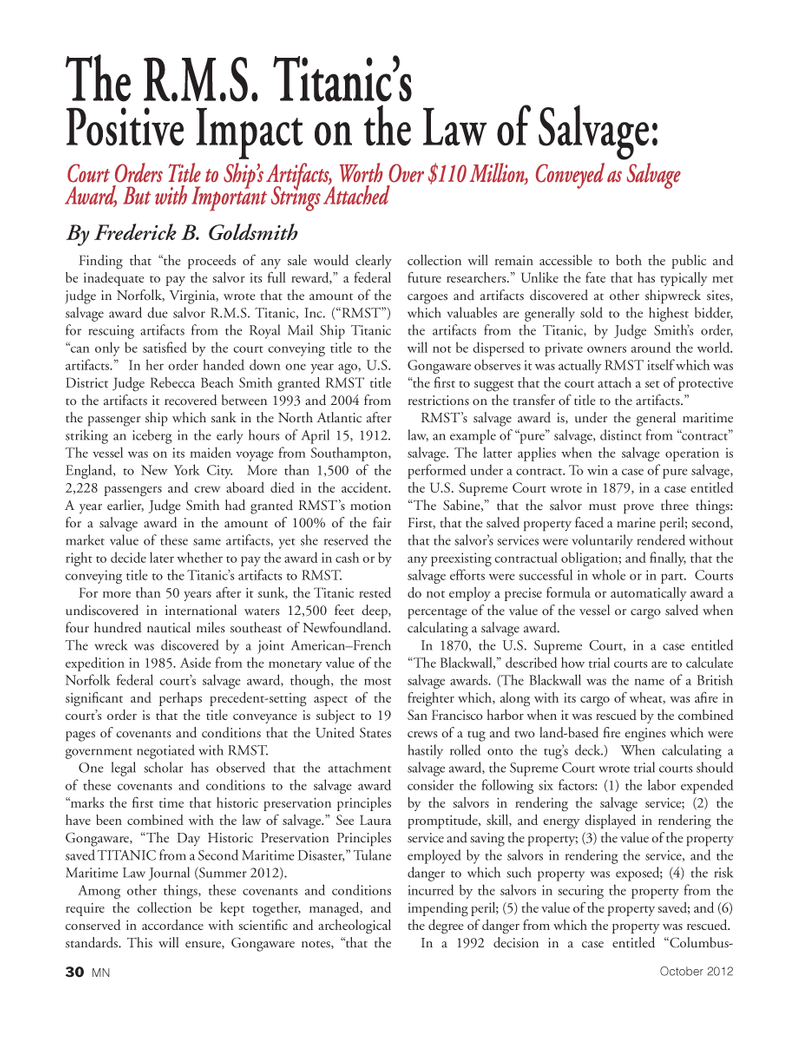
Page 30: of Marine News Magazine (October 2012)
Year in Review & Leadership
Read this page in Pdf, Flash or Html5 edition of October 2012 Marine News Magazine
Finding that ?the proceeds of any sale would clearly be inadequate to pay the salvor its full reward,? a federal judge in Norfolk, Virginia, wrote that the amount of the salvage award due salvor R.M.S. Titanic, Inc. (?RMST?) for rescuing artifacts from the Royal Mail Ship Titanic ?can only be satis ed by the court conveying title to the artifacts.? In her order handed down one year ago, U.S. District Judge Rebecca Beach Smith granted RMST title to the artifacts it recovered between 1993 and 2004 from the passenger ship which sank in the North Atlantic after striking an iceberg in the early hours of April 15, 1912. The vessel was on its maiden voyage from Southampton, England, to New York City. More than 1,500 of the 2,228 passengers and crew aboard died in the accident. A year earlier, Judge Smith had granted RMST?s motion for a salvage award in the amount of 100% of the fair market value of these same artifacts, yet she reserved the right to decide later whether to pay the award in cash or by conveying title to the Titanic?s artifacts to RMST. For more than 50 years after it sunk, the Titanic rested undiscovered in international waters 12,500 feet deep, four hundred nautical miles southeast of Newfoundland. The wreck was discovered by a joint American?French expedition in 1985. Aside from the monetary value of the Norfolk federal court?s salvage award, though, the most signi cant and perhaps precedent-setting aspect of the court?s order is that the title conveyance is subject to 19 pages of covenants and conditions that the United States government negotiated with RMST. One legal scholar has observed that the attachment of these covenants and conditions to the salvage award ?marks the rst time that historic preservation principles have been combined with the law of salvage.? See Laura Gongaware, ?The Day Historic Preservation Principles saved TITANIC from a Second Maritime Disaster,? Tulane Maritime Law Journal (Summer 2012). Among other things, these covenants and conditions require the collection be kept together, managed, and conserved in accordance with scienti c and archeological standards. This will ensure, Gongaware notes, ?that the collection will remain accessible to both the public and future researchers.? Unlike the fate that has typically met cargoes and artifacts discovered at other shipwreck sites, which valuables are generally sold to the highest bidder, the artifacts from the Titanic, by Judge Smith?s order, will not be dispersed to private owners around the world. Gongaware observes it was actually RMST itself which was ?the rst to suggest that the court attach a set of protective restrictions on the transfer of title to the artifacts.? RMST?s salvage award is, under the general maritime law, an example of ?pure? salvage, distinct from ?contract? salvage. The latter applies when the salvage operation is performed under a contract. To win a case of pure salvage, the U.S. Supreme Court wrote in 1879, in a case entitled ?The Sabine,? that the salvor must prove three things: First, that the salved property faced a marine peril; second, that the salvor?s services were voluntarily rendered without any preexisting contractual obligation; and nally, that the salvage efforts were successful in whole or in part. Courts do not employ a precise formula or automatically award a percentage of the value of the vessel or cargo salved when calculating a salvage award. In 1870, the U.S. Supreme Court, in a case entitled ?The Blackwall,? described how trial courts are to calculate salvage awards. (The Blackwall was the name of a British freighter which, along with its cargo of wheat, was a re in San Francisco harbor when it was rescued by the combined crews of a tug and two land-based re engines which were hastily rolled onto the tug?s deck.) When calculating a salvage award, the Supreme Court wrote trial courts should consider the following six factors: (1) the labor expended by the salvors in rendering the salvage service; (2) the promptitude, skill, and energy displayed in rendering the service and saving the property; (3) the value of the property employed by the salvors in rendering the service, and the danger to which such property was exposed; (4) the risk incurred by the salvors in securing the property from the impending peril; (5) the value of the property saved; and (6) the degree of danger from which the property was rescued. In a 1992 decision in a case entitled ?Columbus- The R.M.S. Titanic?s The R.M.S. Titanic?s Positive Impact on the Law of Salvage: Positive Impact on the Law of Salvage: Court Order Court Order s Title to Ship?s Artifacts, Worth Over $110 Million, s Title to Ship?s Artifacts, Worth Over $110 Million, Conveyed as Salvage Conveyed as Salvage Award, But with Important Strings Attached Award, But with Important Strings Attached By Frederick B. Goldsmith 30 MNOctober 2012MNOct2012 Layout 18-31.indd 30MNOct2012 Layout 18-31.indd 3010/2/2012 9:40:19 AM10/2/2012 9:40:19 AM

 29
29

 31
31
